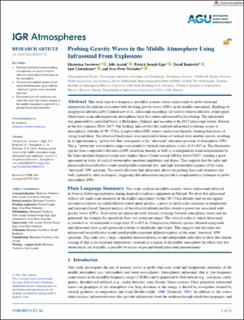| dc.contributor.author | Vorobeva, Ekaterina | |
| dc.contributor.author | Assink, Jelle | |
| dc.contributor.author | Espy, Patrick Joseph | |
| dc.contributor.author | Renkwitz, Toralf | |
| dc.contributor.author | Chunchuzov, Igor | |
| dc.contributor.author | Näsholm, Sven Peter | |
| dc.date.accessioned | 2023-07-25T08:23:27Z | |
| dc.date.available | 2023-07-25T08:23:27Z | |
| dc.date.created | 2023-07-09T01:09:21Z | |
| dc.date.issued | 2023 | |
| dc.identifier.issn | 2169-897X | |
| dc.identifier.uri | https://hdl.handle.net/11250/3081210 | |
| dc.description.abstract | This study uses low-frequency, inaudible acoustic waves (infrasound) to probe wind and temperature fluctuations associated with breaking gravity waves (GWs) in the middle atmosphere. Building on an approach introduced by Chunchuzov et al., infrasound recordings are used to retrieve effective sound-speed fluctuations in an inhomogeneous atmospheric layer that causes infrasound backscattering. The infrasound was generated by controlled blasts at Hukkakero, Finland, and recorded at the IS37 infrasound station, Norway in the late summers 2014–2017. Our findings indicate that the analyzed infrasound scattering occurs at mesospheric altitudes of 50–75 km, a region where GWs interact under non-linearity, forming thin layers of strong wind shear. The retrieved fluctuations were analyzed in terms of vertical wave number spectra, resulting in an approximate urn:x-wiley:2169897X:media:jgrd58816:jgrd58816-math-0001 power law that corresponds to the “universal” saturated spectrum of atmospheric GWs. The urn:x-wiley:2169897X:media:jgrd58816:jgrd58816-math-0002 power law wavenumber range corresponds to vertical atmospheric scales of 33–625 m. The fluctuation spectra were compared to theoretical GW saturation theories as well as to independent wind measurements by the Saura medium-frequency radar near Andøya Space Center around 100 km west of IS37, yielding a good agreement in terms of vertical wavenumber spectrum amplitudes and slopes. This suggests that the radar and infrasound-based effective sound-speed profiles represent low- and high-wavenumber regimes of the same “universal” GW spectrum. The results illustrate that infrasound allows for probing fine-scale dynamics not well captured by other techniques, suggesting that infrasound can provide a complementary technique to probe atmospheric GWs. | en_US |
| dc.language.iso | eng | en_US |
| dc.publisher | Wiley | en_US |
| dc.rights | Navngivelse 4.0 Internasjonal | * |
| dc.rights.uri | http://creativecommons.org/licenses/by/4.0/deed.no | * |
| dc.title | Probing Gravity Waves in the Middle Atmosphere Using Infrasound From Explosions | en_US |
| dc.title.alternative | Probing Gravity Waves in the Middle Atmosphere Using Infrasound From Explosions | en_US |
| dc.type | Peer reviewed | en_US |
| dc.type | Journal article | en_US |
| dc.description.version | publishedVersion | en_US |
| dc.source.volume | 128 | en_US |
| dc.source.journal | Journal of Geophysical Research (JGR): Atmospheres | en_US |
| dc.source.issue | 13 | en_US |
| dc.identifier.doi | 10.1029/2023JD038725 | |
| dc.identifier.cristin | 2161562 | |
| cristin.ispublished | true | |
| cristin.fulltext | original | |
| cristin.qualitycode | 2 | |

